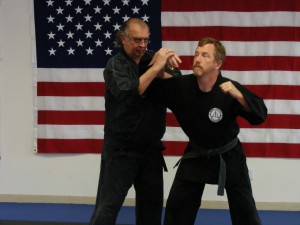 In my classes this past week I have found myself giving the ‘being a good training partner’ talk several times. As a teacher, when you answer the same question a few times, it tells you that it’s probably a good time to go over whatever topic that is prompting these questions with the whole group as there are probably many more class members out there who just haven’t asked yet.
In my classes this past week I have found myself giving the ‘being a good training partner’ talk several times. As a teacher, when you answer the same question a few times, it tells you that it’s probably a good time to go over whatever topic that is prompting these questions with the whole group as there are probably many more class members out there who just haven’t asked yet.
It can be tricky to be a great training partner. The responsibilities involved vary depending on the drill, your partner, and how experienced with the material each of you are. As beginners, and sometimes as advanced practitioners you go through phases of learning material. If you are just learning a technique for the first time, a full power, full speed attack is not what you need. However, if that is all you ever receive, you will never be prepared for reality.
A good model I encountered was taught by Shihan Walt Sento; it was the Feed-Allow-Resist model. In the beginning, a good training partner provides an attack that helps to ‘feed’ the correct response. You commit and help the defender by giving just the right attack for the technique that they are trying to learn. As they get the hang of it, you back off to a neutral attack where the person doing the technique must make it happen on their own but you provide no help. Finally, when they are doing the technique well, you can resist so they know they can pull it off on an uncooperative attacker.
If someone is learning a takedown for the first time, it’s not being a good training partner to resist with all of your might as it make it hard for the person to apply the technique cleanly and they end up trying to ‘muscle through’ with poor form. Give them the opportunity, and even good feedback – like pointing out locations for proper hand placement or footwork. Simply stating ‘You’re doing it totally wrong’ is the hallmark of a poor training partner.
When you finally get to the resist phase, it’s often in a sparring or testing situation. Even then remember – with hard resistance the risk of injury goes up. We should think like a team – injured team members make us weaker as a dojo. We need to provide resistance to make us stronger, but not so much that either one of us gets injured. We are here to get stronger, better, and have better lives. Everything else should lead to that.
Every time I train with another person, I strive to be the best training partner I can be. Sometimes it means I have to be uncomfortable. Sometimes it means I have to put my ego aside and work at a different level to help my partner develop their skill and get the most out of their training. This is how I rate my training. Was I the best training partner I could be today?


Can someone please point me to the school so I can attend?
My school is a garage bay in an industrial park on Cape Cod. This article is aimed at students and teachers at all school to work to create the best experience for all of the students.